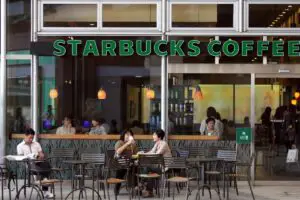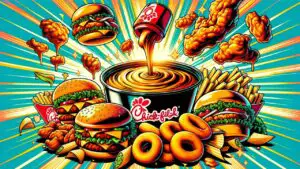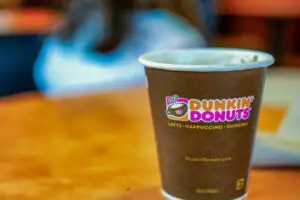Ah, Starbucks – that glorious haven where I can gulp down a piping-hot cup of caffeinated goodness whilst attempting to maintain some semblance of sanity as the mother of three uniquely interesting challenging offspring.
*This post may contain affiliate links. As an Amazon Associate we earn from qualifying purchases.
For me, and numerous others, Starbucks is largely about the coffee. But let’s face it: their food menu is, at times, rather underwhelming.
As an avid coffee enthusiast and food lover, I’ve found myself asking: why doesn’t Starbucks offer more food items? So, fellow coffee lovers and food explorers, grab your cup of joe and join me as we delve into the world of Starbucks, its limited food menu, and the impact on consumers and the market.
Key Takeaways
- Starbucks’ core business model is centered around its coffee offerings, prioritizing high-quality beans and specialty drinks.
- The limited food menu is a strategic decision to maintain a coffee-centric image and focus on the brand’s core competencies.
- Starbucks’ emphasis on customization and personalized beverages caters to the diverse preferences of its customers.
- The company’s operational efficiency is maintained by streamlining menu offerings, optimizing kitchen setup, and managing food inventory.
- Partnerships with local bakeries and responsiveness to emerging food trends contribute to Starbucks’ selective yet dynamic food menu.
- Starbucks’ market positioning emphasizes coffee and the cafe experience, creating an inviting atmosphere for social and collaborative interactions.
- The success of existing food offerings is driven by customer feedback, data-driven decision-making, and expansion in proven categories.
- Comparisons with competitors highlight Starbucks’ unique position and commitment to quality in the cafe industry.
- Potential challenges and risks of expanding the food menu include supply chain management, maintaining operational efficiency, and price and profit margin considerations.
- Future trends that could impact Starbucks’ food offerings include growth and acquisitions, sustainability initiatives, technological innovations, changing consumer preferences, and globalization.
Starbucks’ Core Business Model: Coffee-centric Approach
Before we start questioning their limited food options, it’s essential to understand Starbucks’ foundation as a coffee shop.
In the beginning, Starbucks mainly focused on selling high-quality coffee beans and coffee-making equipment. It wasn’t until sensible people like yours truly realized that consuming copious amounts of caffeine was necessary to survive that Starbucks expanded into brewed coffee and eventually the infamous Frappuccinos.
Quality coffee is the lifeblood of Starbucks. That’s what sets them apart and continues to be their main selling point. Their focus on specialty drinks and customization options – like the incredibly appreciated triple-shot, half-caff, soy, extra-foam, caramel-drizzled latte – only reinforces the brand’s association with coffee.
So, naturally, their primary focus is on excellent coffee and mastering the dark nectar of energy before broadening the food offerings.
Historical background: Starbucks’ foundation as a coffee shop
Remember the story of the Seattle walk-up stand called Starbucks Coffee, Tea and Spice that was primarily dedicated to selling high-quality coffee beans? Ever since that moment in 1971, Starbucks has been all about the perfect cup of joe.
The concept of the neighborhood coffee house was introduced in the mid-1980s, when local resident Howard Schultz had an “aha” moment inspired by Italian espresso bars. From that point on, Starbucks gradually evolved into the enticing espresso-scented siren we know and love now, becoming the hangout spot for coffee lovers and those seeking a cozy corner to relax, work, or chat.
Focusing on quality: Distinguishing factors of Starbucks coffee
Every coffee aficionado knows that not all coffee is created equal, and that’s where Starbucks shines. Their insistence on quality – hand-selected beans, ethical sourcing, and perfect roasting – sets the foundation for that magical, energizing elixir.
The last thing you want when you’re craving caffeine is a questionable, possibly burnt, and flavorless brew. (Looking at you, Mr. Gas Station Coffee.) With over 87,000 possible drink combinations <insert gasp> to suit everyone’s individual taste, Starbucks excels at offering a personalized coffee paradise.
Specialty drinks: Importance of customizable beverages
We caffeine guzzlers come in all shapes, sizes, and preferences. Some of us like to spice things up with a seasonal Pumpkin Spice Latte. Others need that straight black coffee, no frills or fuss. Starbucks knows this, and one of its best features is the plethora of customizable options.
Swing by your local Starbucks, and you’ll witness hardworking baristas concocting deliciously creative libations like toffee nut macadamia frapps with extra sprinkles and my personal favorite (spoiler alert) – the classic, soothing, warm-your-soul caramel macchiato.
Reinforcing brand identity: Associating Starbucks primarily with coffee
Let’s face reality, folks. When you say Starbucks, everyone’s mind jumps straight to their favorite coffee drink. Their brand identity is unshakably linked to coffee, and that’s a strategic move on their part.
Expanding the food menu might dilute that coffee-centric image, leading customers to wonder whether Starbucks has lost focus on their coffee quality. We all know who specializes in golden arches and fast food, right?
Starbucks is to coffee as McDonald’s is to burgers and fries. A little food on the side is appreciated, but Starbucks remains unapologetically committed to its caffeinated roots.
Customer expectations and core competencies: Reasons to prioritize coffee products
Imagine walking into a cheesecake factory, only to realize that their cheesecake selection has diminished in favor of more savory dishes. Not quite the experience you were looking for, right?
Starbucks knows that its customers mainly visit for their expertly-crafted coffee concoctions. So, they focus on honing their coffee-brewing skills and innovating new products while providing a beautifully limited food menu (that could, admittedly, use some more extensive sandwich and pastry options).
Focus on your strengths, and the caffeinated crowd will keep coming back for more lattes, mochas, and espressos galore!
Operational Efficiency: Streamlining Menu Offerings
One of the most critical factors in Starbucks’ success is their operational efficiency. They’re well aware that speed, consistency, and flawless execution are the keys to maintaining their popularity.
Hang with me as we dig into the logistics that come into play when navigating this coffee kingdom’s operational efficiency, from keeping kitchen equipment to a minimum, expertly managing food inventory, and catering to regional and seasonal must-haves.
Importance of speed and consistency: Prioritizing customer experience
Ever experienced that glorious moment when you reach the front of the line, and the barista has already begun skillfully crafting your precisely customized drink, prepared just as you worship it? This speedy triumph is no mere coincidence – Starbucks has intentionally optimized and streamlined its menu to prioritize customer experience.
And while we all love to indulge in scrumptious food options, a complex menu requires more prep work, ultimately slowing down the process. Starbucks knows that we live and breathe the phrase “time is money” (or in this case, caffeine) and strikes a balance between satisfying hunger pangs and keeping the line moving swiftly.
Kitchen setup and equipment limitations: Impact on food options
When I kicked off my motherly career with my first child, my kitchen transformed from a haven of food experimentation to a streamlined battlefield, equipped with the essentials to whip up quick meals and snacks that would appease my baby’s never-ending hunger.
Starbucks faces a similar challenge.
Each store is built for efficiency, with minimal space dedicated to food prep. This equipment minimalism helps baristas maneuver with unfaltering grace, whipping up beverages like caffeine-fueled ballerinas.
Logistically, offering the world of hassle-free, satisfying on-the-go foods will require changes in the kitchen setup, impacting their ability to maintain the speed and quality of coffee service we’ve come to adore.
Inventory management: Reducing waste and maintaining freshness
If you’ve ever unintentionally experimented with your refrigerator’s contents to concoct a meal from random ingredients before they spoil, you’ll understand the challenges of inventory management. Maintaining a more extensive food menu requires a delicate juggling act to avoid stock-outs, excess inventory, and food waste.
Nobody relishes the panicked discovery of moldy bread during a sandwich-making session, and Starbucks is no exception. By keeping their food menu limited, Starbucks maintains the delicate balance of freshness, reducing waste while providing a satisfying variety of snacks and light meals.
Staff training: Simplifying processes to maintain service standards
My personal anecdote here: I couldn’t even make decent scrambled eggs until my 20s, so think of the training and time investment needed to perfect various culinary skills. Starbucks, being dedicated to consistently exceptional quality, simplifies its process by maintaining a manageable food menu.
This way, baristas spend less time learning various dishes and more time mastering the art of crafting caffeinated delights. As much as we would appreciate a Starbucks-educated MasterChef, giving baristas ample time to focus on their coffee skills is probably way more important to our morning routine.
Seasonal and regional offerings: Flexibility with limited food options
Seasons change, and so do our appetites. Starbucks expertly capitalizes on this, offering seasonal and regional food options, limited in scope so as not to disrupt their business model. From gingerbread loaf during the holidays to pumpkin scones in autumn, Starbucks caters to our cravings without straying too far from their coffee-centric haven.
Their culinary flexibility within a limited menu framework keeps us coming back, wondering what tasty seasonal treat will complement our favorite beverages next.
Partnerships and External Factors: Influencing Starbucks Food Choices
Diving a little deeper into Starbucks’ food world, let’s unveil some of the partnerships and external factors that drive their menu choices.
From collaborations with local bakeries to maintaining a keen eye on food trends, Starbucks’ ability to respond to customer demand and address dietary concerns is the secret sauce to their selective yet dynamic food menu.
Collaborations with local bakeries: Utilizing existing food production infrastructure
Instead of attempting to become master bakers themselves, Starbucks takes the much smarter approach of collaborating with local bakeries. In doing so, they utilize existing food production infrastructure to maintain a steady stream of delightful pastries and snacks, while streamlining their kitchen gear to focus on their divine coffee.
Collaborating with local businesses helps maintain a balanced and manageable food selection while supporting local communities— a win-win for all caffeinated parties.
Responding to emerging food trends: Balancing variety and specialty
Starbucks may not delve into a vast food menu, but they certainly know how to keep tabs on emerging trends. Whether it’s adding avocado spread to cater to the avocado toast craze or plant-based sandwiches for the increasingly health-conscious, Starbucks strikes a balance between variety and specialty.
They embrace change without going overboard, keeping the menu focused yet fresh and trendy.
Health and wellness factor: Including healthier food options
As a mother, I can vouch for the constant guilt that comes with every dessert consumed. It’s a relief to see that Starbucks has made an effort to cater to the health-conscious by offering a range of healthier options, like protein boxes and reduced-fat choices.
Nutritional balance is crucial, and even though we’re primarily visiting for coffee, let’s not forget the importance of keeping our bodies nourished and energized.
Legislative and regulatory factors: Impacts on food options and sourcing
Gone are the carefree days where we consumed whatever concoctions filled our cravings without a second thought. Now, we navigate ever-changing legislative and regulatory requirements, which also affects Starbucks’ food offerings.
From ensuring ethical sourcing standards to addressing allergens and complying with varying state and local restrictions, Starbucks has its work cut out for them—even within its limited food menu.
Props to Starbucks for acknowledging that we, as consumers, have become increasingly demanding in catering to our dietary quirks—whether out of necessity, preference, or avoidance of divine retribution.
Their limited food menu still manages to address various dietary concerns, including vegetarian, gluten-free, and dairy-free options. Implementing changes that cater to diverse dietary needs while avoiding menu bloat is a challenge that Starbucks gracefully navigates.
Market Positioning: Emphasis on Coffee and Cafe Experience
At the heart of Starbucks is a robust caffeinated love affair, and their market positioning emphasizes their commitment to high-quality coffee and a cozy cafe experience.
From ambience and target audience to their competitive strategy and price points, Starbucks understands the importance of maintaining a distinguished market position over expanding their food menu to become just ‘another cafe.’
Environment and ambiance: Drawing customers in for the atmosphere
Ever noticed the comforting aroma of coffee that envelops you the moment you step into a Starbucks? That seductive ambience is by design!
Their cozy atmosphere, coupled with their exceptional caffeinated offerings, creates an environment that welcomes us for everything from a quiet morning coffee to catching up with friends over a warm brew. Starbucks’ emphasis on ambiance largely contributes to its unmistakable identity and loyal customer base.
Target audience: Catering to coffee aficionados and casual sippers
Ever watched a discerning coffee aficionado taking pride in their chosen cup of joe, discussing everything from aroma to body? I feel you.
Starbucks knows that, whether you’re a coffee connoisseur or simply craving that caffeine fix, you value quality coffee—and they tailor their offerings accordingly. While their limited food menu provides a tasty complement, their coffee prowess is the true star that keeps both aficionados and casual sippers coming back for more.
Competitive strategy: Differentiating from fast-food chains
Starbucks is not your average fast-food chain, and they’re well aware of this distinction. Expanding their food menu to match fast-food chains would blur the lines between them and their competitors, putting their unique market position at risk.
Focusing primarily on signature coffee and beverages sets Starbucks apart, with a smattering of food options to keep us satisfied without losing their essence.
Starbucks is known for premium prices, and their food menu reflects that. Whether it’s a beautifully moist slice of banana bread or that heavenly turkey and pesto sandwich, each menu item is designed to align with their premium image.
We wouldn’t expect bare-bones prices from Starbucks (nor should we), and their commitment to quality ingredients justifies the price while keeping the menu selective to avoid overshadowing their coffee offerings.
Social and collaborative aspects: Encouraging spontaneous visits and group gatherings
Ever had that unexpected coffee meeting with your boss, coworker, or a fateful stranger that led to a productive conversation? Starbucks fosters an environment where we can spontaneously engage in social and collaborative interactions while sipping on our favorite coffee.
Expanding their food menu may free up more options for hungry visitors, but Starbucks’ commitment to preserving an inviting social space is something many of us truly appreciate.
Success of Existing Food Offerings: Analyzing Current Menu Choices
Despite its restricted food menu, there’s no denying that Starbucks does an impressive job catering to our hunger cravings. They keep a finger on the pulse of popular, in-demand items, respond to customer feedback, and strategically introduce limited-time offers and seasonal items.
All of these, combined with data-driven decision-making, allow Starbucks to focus on expanding successful categories while still prioritizing their coffee excellence.
Best-selling food items: Focusing on in-demand options
No one can resist the allure of a scrumptious lemon loaf or a comforting blueberry muffin. Both classic and innovative items coexist in Starbucks’ limited food menu, and each addition is carefully selected based on consumer demand.
By focusing on the most sought-after options, Starbucks keeps us coming back for those beloved favorites while they continue to excel in their coffee crafting.
Customer feedback and favorites: Catering to loyal customers’ preferences
Starbucks knows how important it is to cater to customer feedback, and we appreciate them oh so much for it. By gauging patron preferences and identifying which items hit the sweet spot, Starbucks ensures that their limited food menu continues to satisfy the masses.
Our voices (and tastebuds) matter, and Starbucks’ willingness to accommodate our feedback cements their place as a highly regarded coffee haven.
Limited-time offers and seasonal items: Driving interest with exclusivity
Limited-time offers and seasonal items tap into our innate love for all things exclusive and scarce. Starbuck’s creative seasonal food selections keep us intrigued and wanting more. Their ever-rotating menu items generate excitement and anticipation for the next tantalizing treat.
With every new offering, Starbucks embraces our shared appreciation for both novelty and nostalgia.
Starbucks knows that rapid changes in consumer preferences and trending food items would be hard to keep up with if left to mere intuition alone. Employing a data-driven decision-making process helps Starbucks analyze trends and demands to optimize its limited but robust menu.
This approach keeps their food offerings both relevant and profitable, without jeopardizing their focus on coffee expertise.
Expanding on successful categories: Building on proven food options
While keeping a limited food menu, Starbucks doesn’t shy away from building on successful categories. Whether it’s adding more plant-based options or introducing a wider range of protein-packed snacks, Starbucks takes the best of the best and expands on it.
This approach allows them to stay current while remaining true to their coffee-centric core.
Comparisons to Competitors: Evaluating Industry Standards
Comparing Starbucks’ food offerings to those of competitors within the industry can shed some light on how they stand in the market.
Aligning with industry trends and customer expectations, pricing and quality analysis, demographic preferences, and evaluating competitor successes and failures all play into how Starbucks designs its food menu.
Examining competitors’ menus offers insights into how Starbucks fits into the ever-evolving food landscape. While some competitors may have a wider range of food offerings, Starbucks maintains its stance on upholding its primary focus on coffee.
By prioritizing consistency and quality in a limited food menu, Starbucks remains a top choice for customers seeking that unmatched coffee experience.
Aligning with industry trends and consumer expectations
Starbucks stays aware of industry trends and manages to match customer expectations without straying from their core business.
The effort to expand their food offerings slowly and intentionally – while maintaining focus on quality coffee – sets Starbucks apart in the highly competitive cafe industry.
Price and quality analysis: Weighing the trade-offs
It’s essential to understand that in the world of food and coffee, quality often correlates with price. Starbucks maintains a reputation for high-quality coffee and food options, which in turn justifies the relatively higher prices customers are willing to pay.
While competitors may offer more extensive food menus at a lower price point, Starbucks’ selective offerings align with their focus on quality ingredients, alluring flavors, and satisfying overall experience.
Customer demographic preferences and spending habits
It’s no secret that preferences and spending habits vary between different customer demographics. Starbucks understands this, as they tailor their food and drink offerings to appeal to both the discerning coffee enthusiast and the casual sippers.
By sticking to a limited food menu, Starbucks maintains its cache among customers who are more focused on their exquisite coffee offerings and overall cafe experience.
Evaluating competitors’ successes and failures
One of the best ways to understand the challenges and rewards of food menu expansion is to learn from the experiences – both successes and failures – of competitors.
Starbucks can glean insights from the risks, rewards, and reactions to food offerings by other industry players, calibrating their menu choices to fit their brand and market position without diluting their emphasis on coffee.
Potential Challenges and Risks: Exploring Menu Expansion Possibilities
If Starbucks were to delve into more extensive food options, they would face numerous challenges and potential risks.
Ensuring quality and consistency in supply chains, maintaining operational efficiency with a more complex menu, managing price and profit margins, and competing with well-established food chains all need to be considered.
Supply chain and sourcing challenges: Ensuring quality and consistency
Starbucks’ commitment to quality would require continuous assurance of top-notch ingredients as they expand their food offerings. This would entail navigating increasingly intricate supply chains, sometimes facing sourcing challenges, and dealing with fluctuations in ingredient quality, availability, and cost.
An extensive food menu could further complicate these tasks and strain the company’s resources.
Balancing food innovation with operational efficiency
Introducing new and innovative food options without sacrificing operational efficiency can pose difficulties.
From the complexity of cooking techniques and ingredients to equipment and training, innovate menu additions must be carefully weighed against the time, resources, and risks involved without jeopardizing their impeccable brewing standards.
Managing price and profit margins for expanded food offerings
Expanding its food menu would expose Starbucks to considerable cost risks, including fluctuating ingredient prices and potential erosion of profit margins.
Striking the right balance between the costs of food supplies and continuously delivering a premium customer experience would be an ongoing challenge.
Competing with established food chains: Assessing brand reception risks
A more extensive food menu could potentially dilute brand perception, putting Starbucks at risk of becoming “just another cafe.”
However, walking the fine line between satisfying food-related customer demands and preserving their identity as a premium coffee haven is a delicate balancing act.
If Starbucks were to expand its food menu, rigorous testing, trial periods, and fine-tuning would be essential to ensure a successful launch.
Introducing new food items requires careful evaluation of customer reception, product performance, feedback, and potential adjustments – a time-intensive and demanding endeavor that may shift focus from their coffee-centric mission.
Future Predictions and Trends: Analyzing the Evolving Food Landscape
As we look to the future, it’s exciting to consider the potential trends and changes in the food landscape that could shape Starbucks’ menu options.
Growth and acquisitions, sustainability initiatives, technological innovations, and a rapidly changing global market could all have an impact on how the empire expands its food offerings.
Starbucks has been no stranger to growth and acquisitions, with past endeavors including La Boulange Bakery and Teavana. These acquisitions have influenced their food and beverage offerings, and there are
likely more to come in the future. Mergers and acquisitions of food-related brands can provide Starbucks with the opportunity to expand and diversify its food offerings without compromising its core focus on coffee.
As the world becomes increasingly environmentally conscious, Starbucks will undoubtedly be looking for ways to implement sustainable practices in every aspect of its operation, including food offerings.
By considering waste reduction and sustainable sourcing, Starbucks can make informed decisions when refining or expanding its food menu, potentially influencing which items make the cut.
Industry innovations: Technology and delivery impacting food offerings
As technology continues to change how we interact with and purchase food, Starbucks will need to adapt and innovate to stay relevant.
Integration of mobile ordering and pickup, along with potential partnerships with delivery services, could influence their food offerings, both in terms of the dishes they serve and how they make them available to customers.
Just as Starbucks has responded to health trends and consumer preferences in the past, they will continue to adapt and innovate to meet changing demands.
As consumers become more health-conscious, plant-based diets gain popularity and convenience becomes king, Starbucks will need to stay attuned to these trends to maintain its appeal and competitive edge.
Globalization: Effects on food options and cultural preferences
As Starbucks’ presence grows across the globe, it’s important to consider how regional and cultural preferences may shape their food offerings.
Adapting to local tastes and accommodating regional specialties will help Starbucks stay relevant and appealing to customers, ensuring their success in diverse markets worldwide.
Conclusion: Reevaluating Starbucks’ Food Menu Strategy
As we’ve explored throughout this caffeinated journey, Starbucks’ limited food menu isn’t a mere fluke or oversight; it’s a calculated decision based on numerous factors, from maintaining focus on coffee craftsmanship to prioritizing operational efficiency.
While there are certainly opportunities for Starbucks to expand and improve its food offerings, it’s crucial to appreciate the balance they’ve struck between satisfying our cravings and providing exceptional coffee and customer experiences.
Starbucks has undoubtedly evolved throughout the years to serve its customers better, and their food menu will continue to do so as the landscape changes. As patrons and coffee enthusiasts, we can appreciate Starbucks for the comforting coffee haven it is, with a food menu that caters to our needs as a tasty sidekick to our beloved brews.
We can only hope for further inquiry and discussion on this topic, and perhaps even some mouth-watering new additions in the future. But for now, let’s raise our cups to Starbucks for keeping us caffeinated, fed, and altogether happier one coffee at a time. Cheers!









